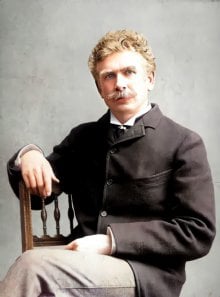Overview
Ambrose Bierce’s 1890 short story "An Occurrence at Owl Creek Bridge" is a tightly constructed tale of the American Civil War that explores perception, time, and the boundary between reality and illusion. It follows Peyton Farquhar, an Alabama planter and ardent Confederate sympathizer, who faces execution by Union soldiers on a railroad bridge. Through a three-part structure, Bierce shifts from clinical realism to heightened psychological experience, culminating in a startling reversal that reframes everything the reader has witnessed.
Plot Summary
The story opens on Owl Creek Bridge where Union soldiers prepare to hang Peyton Farquhar. The scene is described with precise military ritual: a plank, a noose, a silent company, and a captain who will signal the execution. Farquhar stands on the plank with hands bound, eyes fixed on the swift water below. In the tense moments before the drop, he notices a piece of driftwood and hears, distorted and magnified, the ticking of his watch, as if time itself is being stretched.
A flashback reveals how Farquhar came to stand on the bridge. A prosperous planter prevented by circumstance from joining the Confederate army, he yearns for a chance at distinction. A soldier in gray rides to his plantation and mentions that the Union has repaired Owl Creek Bridge and posted a warning against sabotage. The visitor hints that the bridge is vulnerable. Eager to serve the Southern cause, Farquhar later goes to the bridge at night. Only afterward is it revealed that the man in gray was a Union scout in disguise; Farquhar has been lured into a trap and captured.
The narrative returns to the bridge as the sergeant steps off the plank. Farquhar drops, but in the instant the rope seems to snap. He plunges into the stream, the noose loosens, and he surfaces, keenly alive to light, sound, and sensation. He evades rifle fire and cannon shot, swims to shore, and runs through the forest all night. His senses thrum with exaggerated detail, the colors of leaves, the pain in his neck, the feel of the road beneath his feet. Near collapse, he reaches his gate at dawn, sees his wife on the veranda, and moves to embrace her. At that moment he feels a stunning blow on his neck. The final sentence reveals the truth: Peyton Farquhar is dead, his body hanging from the Owl Creek Bridge, neck broken. The escape was an elaborate fantasy compressed into the last instant of consciousness.
Themes
Bierce probes the fragility of perception and the human mind’s capacity to create sustaining illusions in the face of death. Farquhar’s imagined flight reasserts dignity, agency, and homecoming, values he cherishes, only to be annihilated by the impersonal machinery of war. The story interrogates romantic notions of heroism, showing how bravado and credulity lead to ruin.
Time and subjectivity are central. The dilated moment on the bridge becomes an eternity in Farquhar’s mind. Sensory amplification and distorted chronology convey how, under extreme stress, interior time detaches from external reality. Deception, by the Union scout, by Farquhar’s self-image, and by narrative perspective, underscores the instability of truth in wartime.
Style and Structure
The tripartite design shifts from detached, objective description to backstory exposition and then to intensely subjective stream-like narration. Bierce’s precise diction, ironic tone, and manipulation of point of view create a powerful misdirection: the third section reads as realistic adventure until the final line retroactively recodes it as hallucination. Details of military procedure and physical environment lend verisimilitude that makes the ultimate twist both shocking and credible.
Significance
"An Occurrence at Owl Creek Bridge" stands as a landmark of American short fiction, blending realism with psychological impressionism and anticipating modernist techniques. Its closing reversal remains one of literature’s most memorable, and its meditation on war’s deceptions and the mind’s desperate artistry continues to resonate.
An Occurrence at Owl Creek Bridge
A Civil War-era story about Peyton Farquhar, a Confederate sympathizer who is about to be hanged by the Union army. A series of events leads him to escape, but the story ends with a twist when the escape is revealed to have been an illusion.
Author: Ambrose Bierce
 Ambrose Bierce, an influential American author and journalist known for his wit, Civil War stories, and The Devil's Dictionary.
Ambrose Bierce, an influential American author and journalist known for his wit, Civil War stories, and The Devil's Dictionary.
More about Ambrose Bierce
 Ambrose Bierce, an influential American author and journalist known for his wit, Civil War stories, and The Devil's Dictionary.
Ambrose Bierce, an influential American author and journalist known for his wit, Civil War stories, and The Devil's Dictionary.